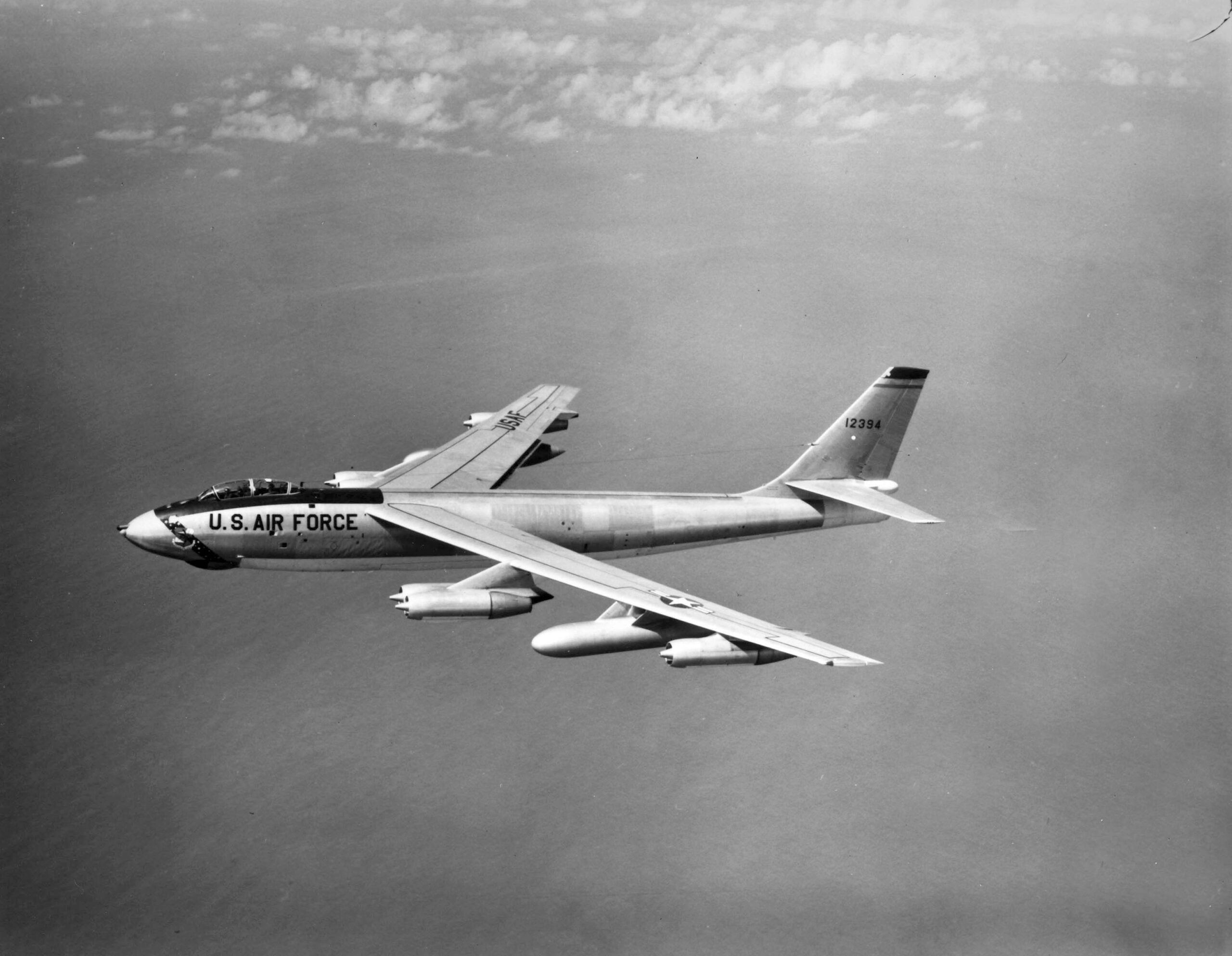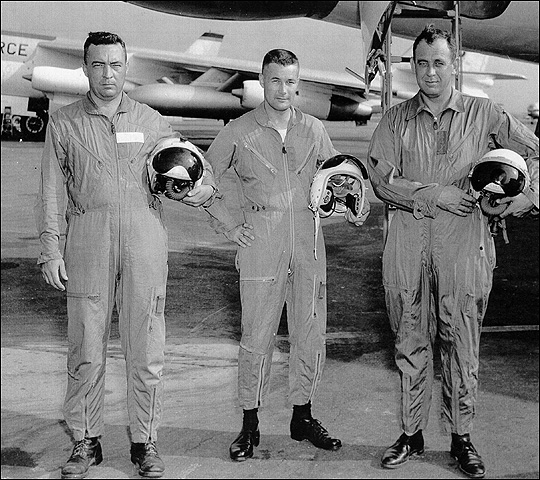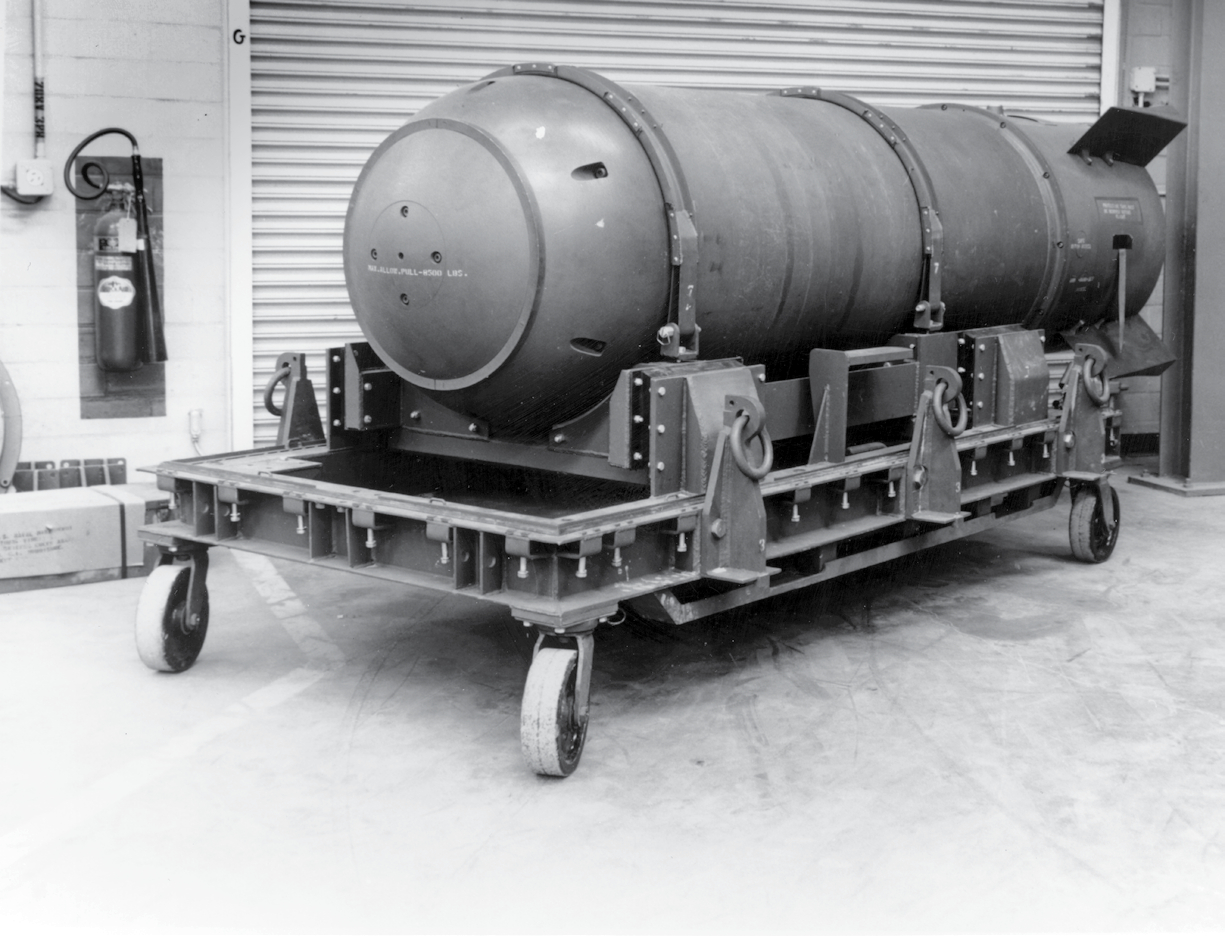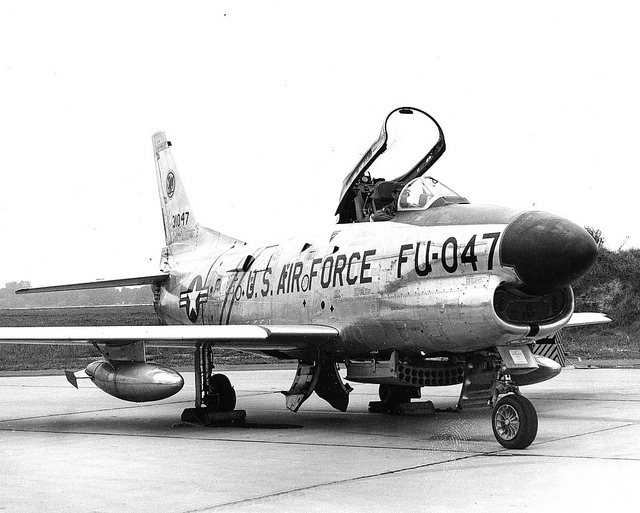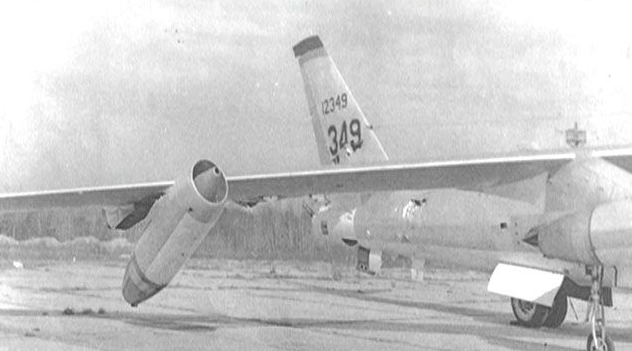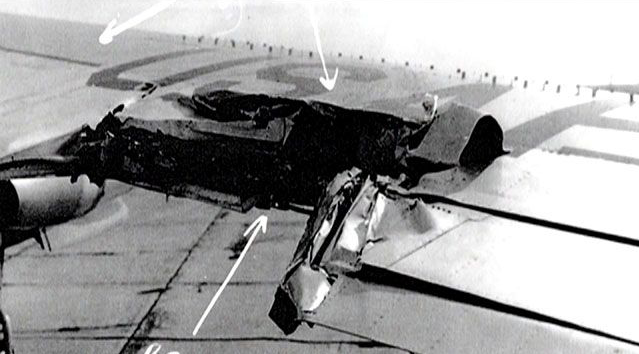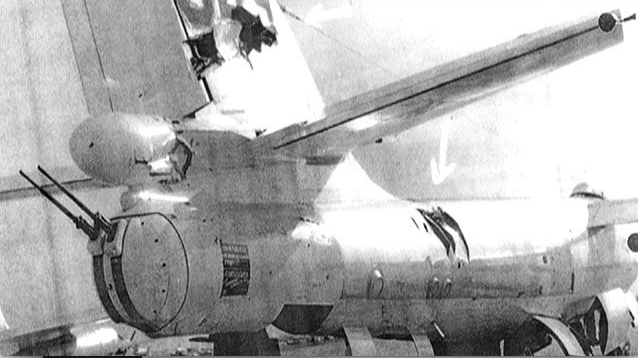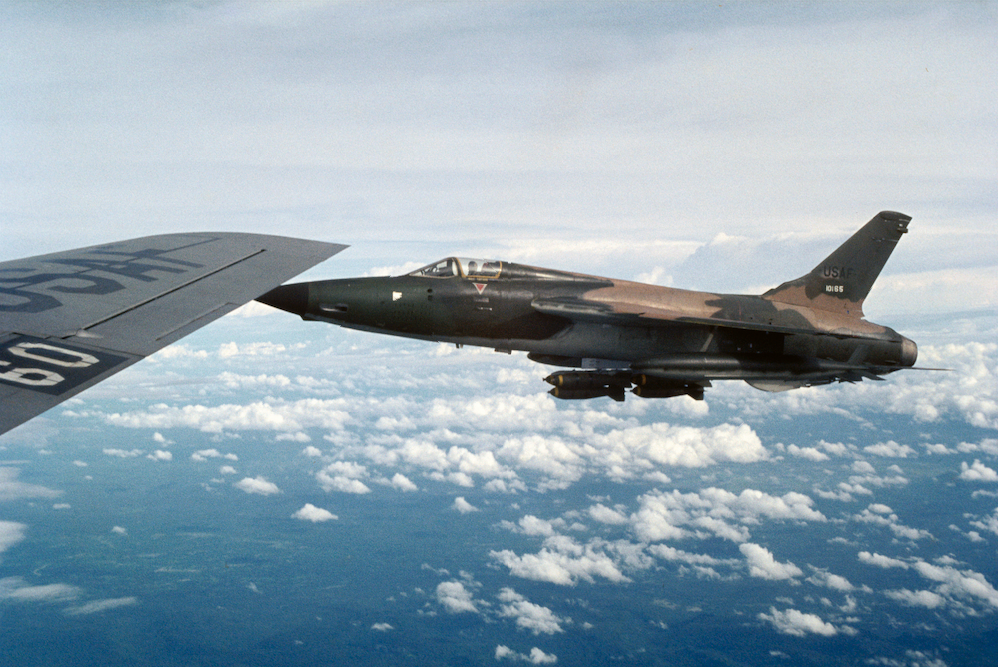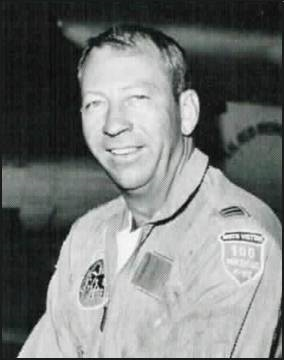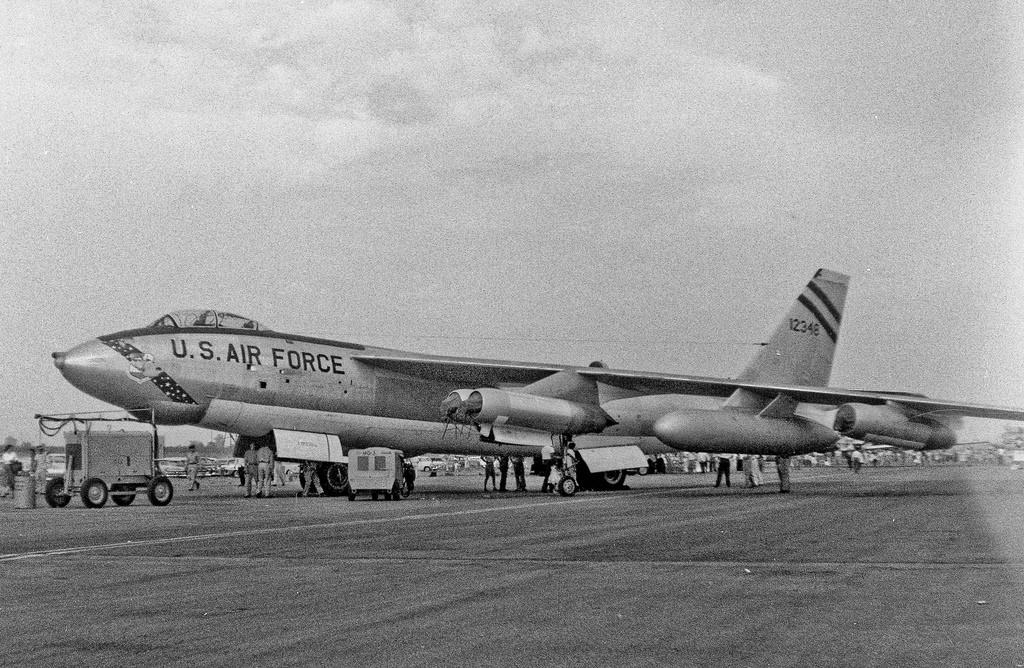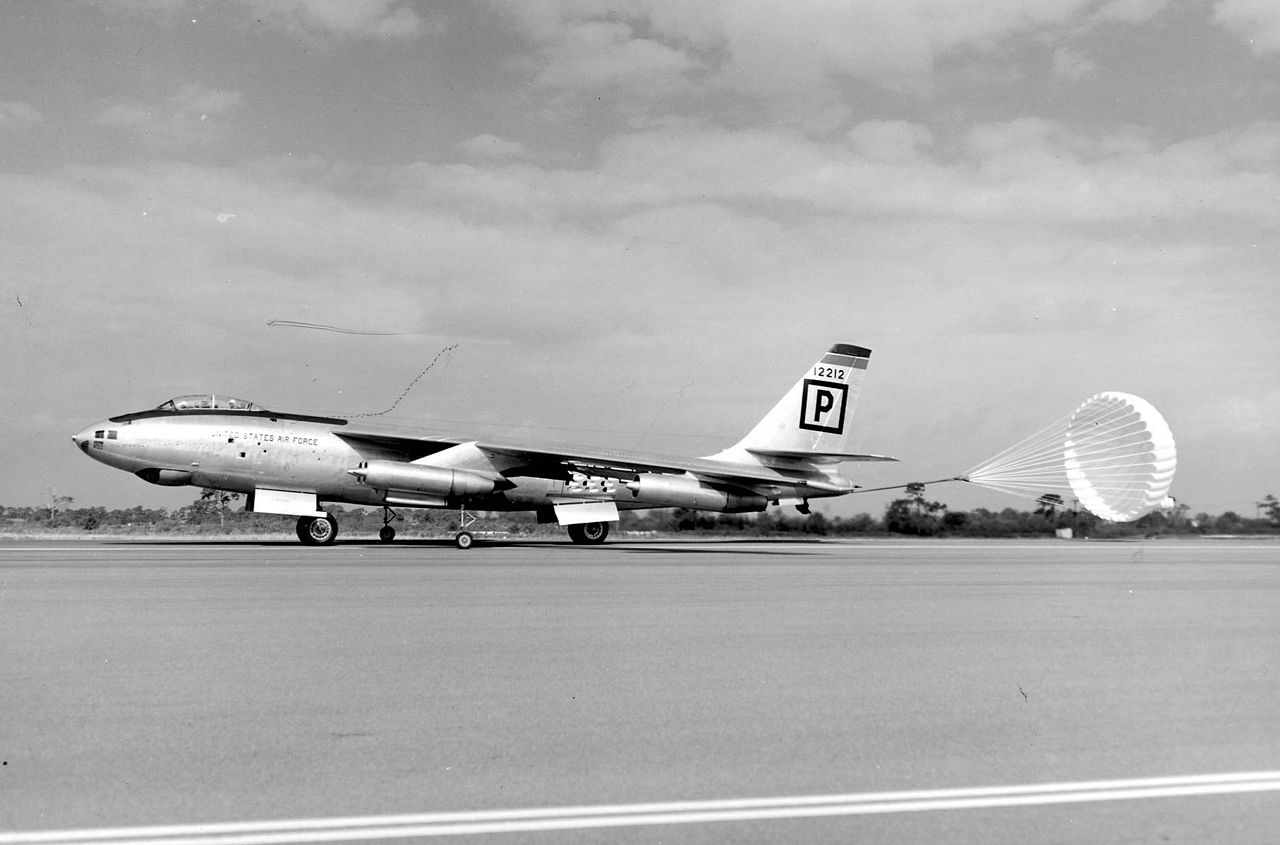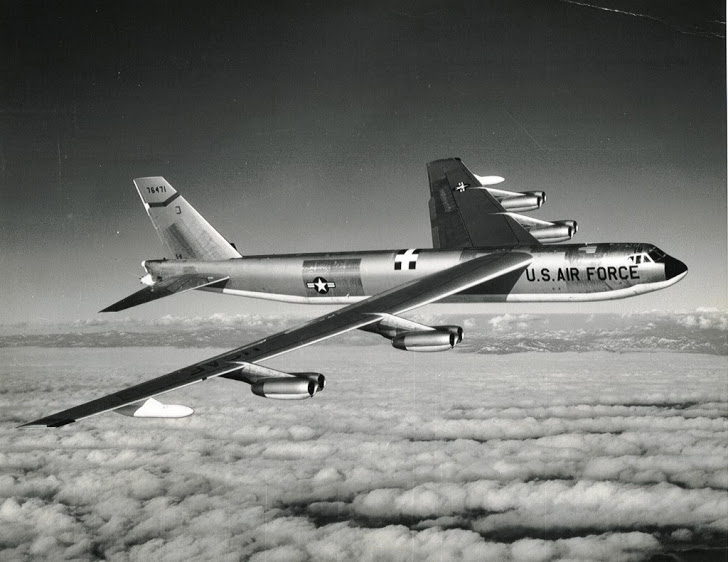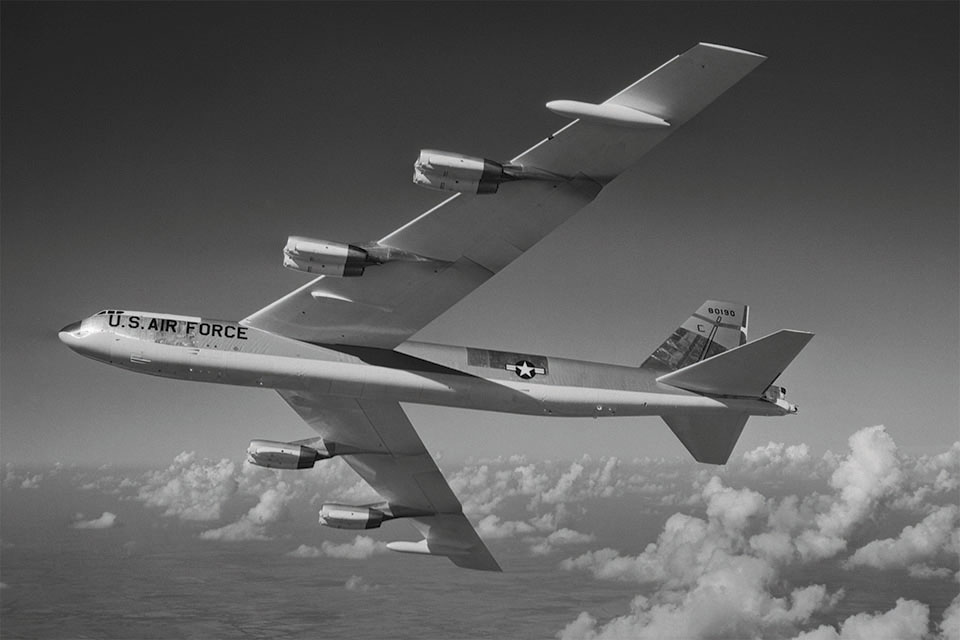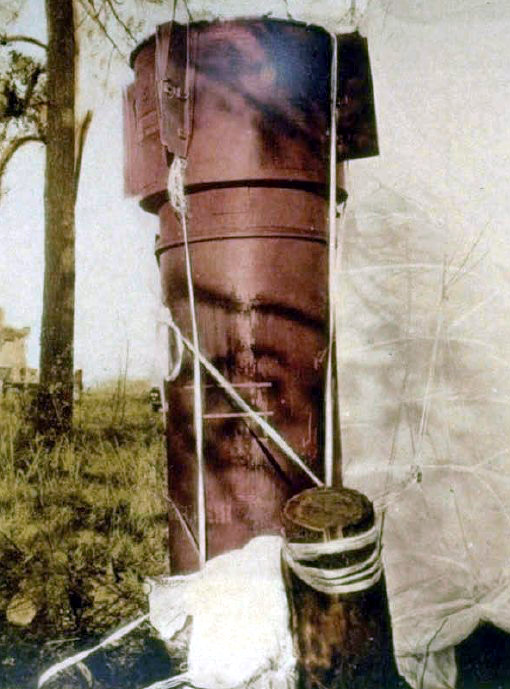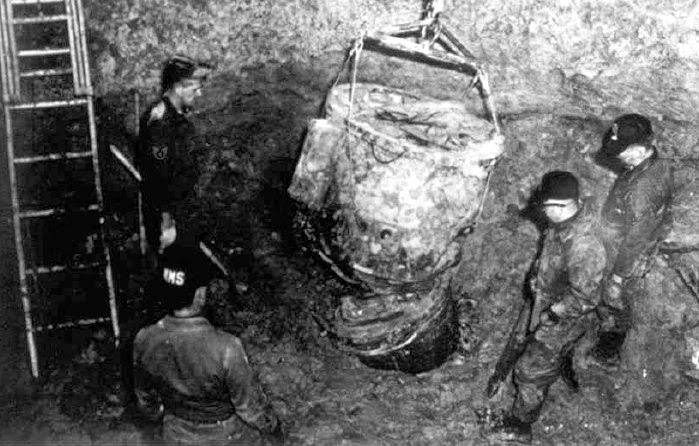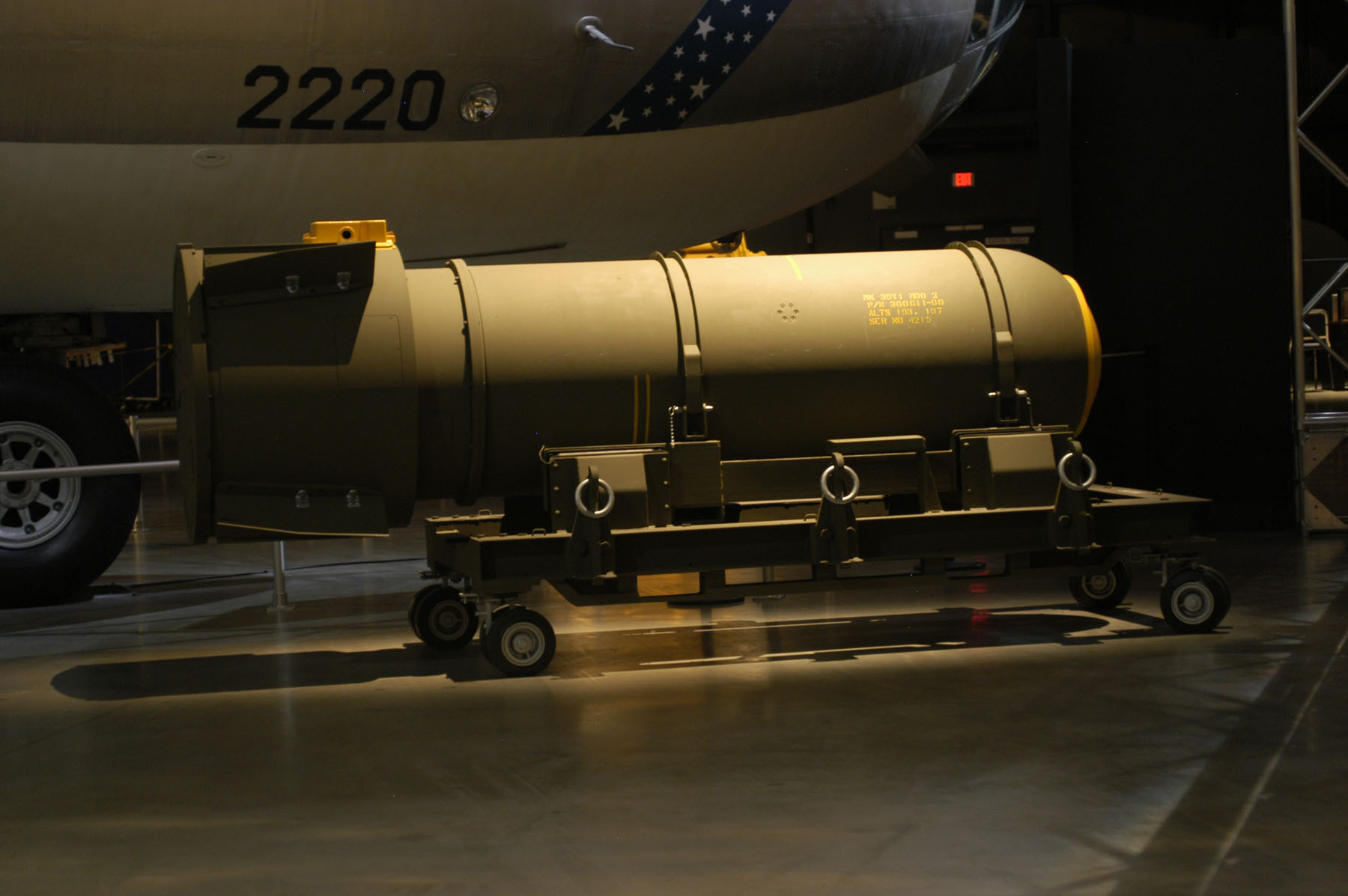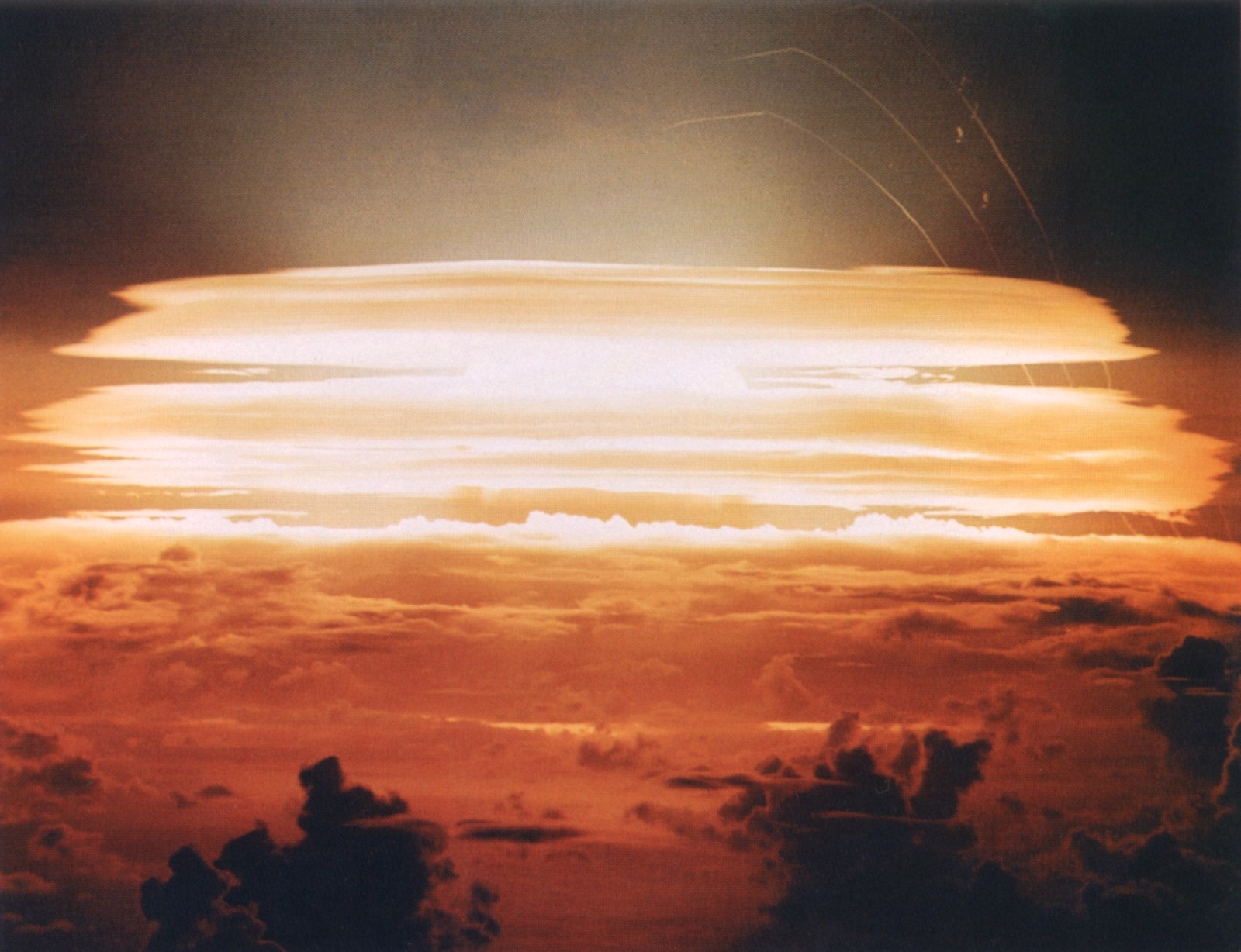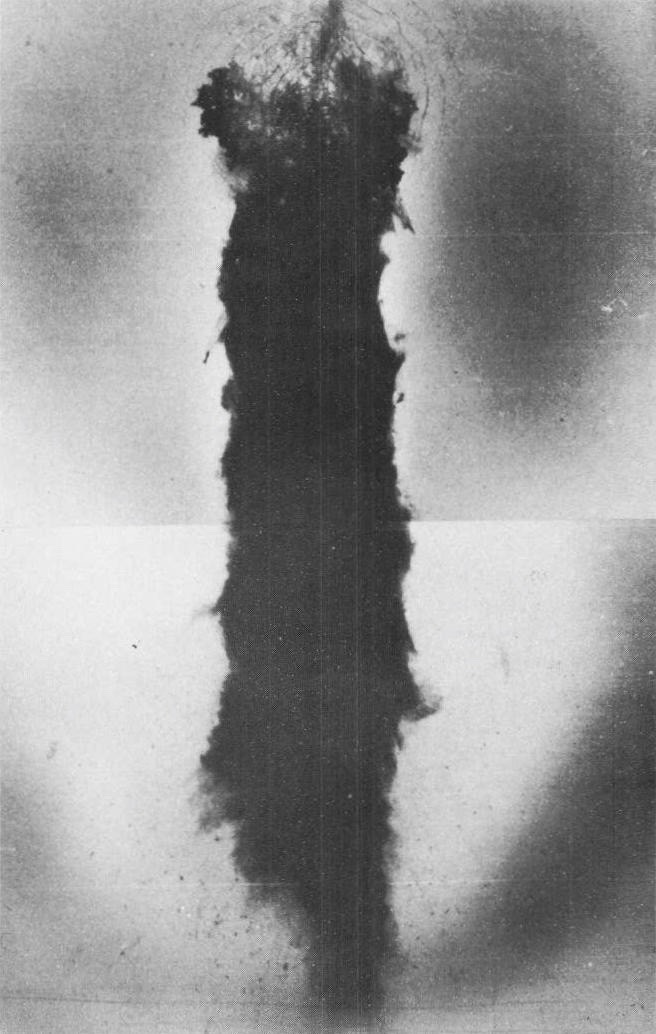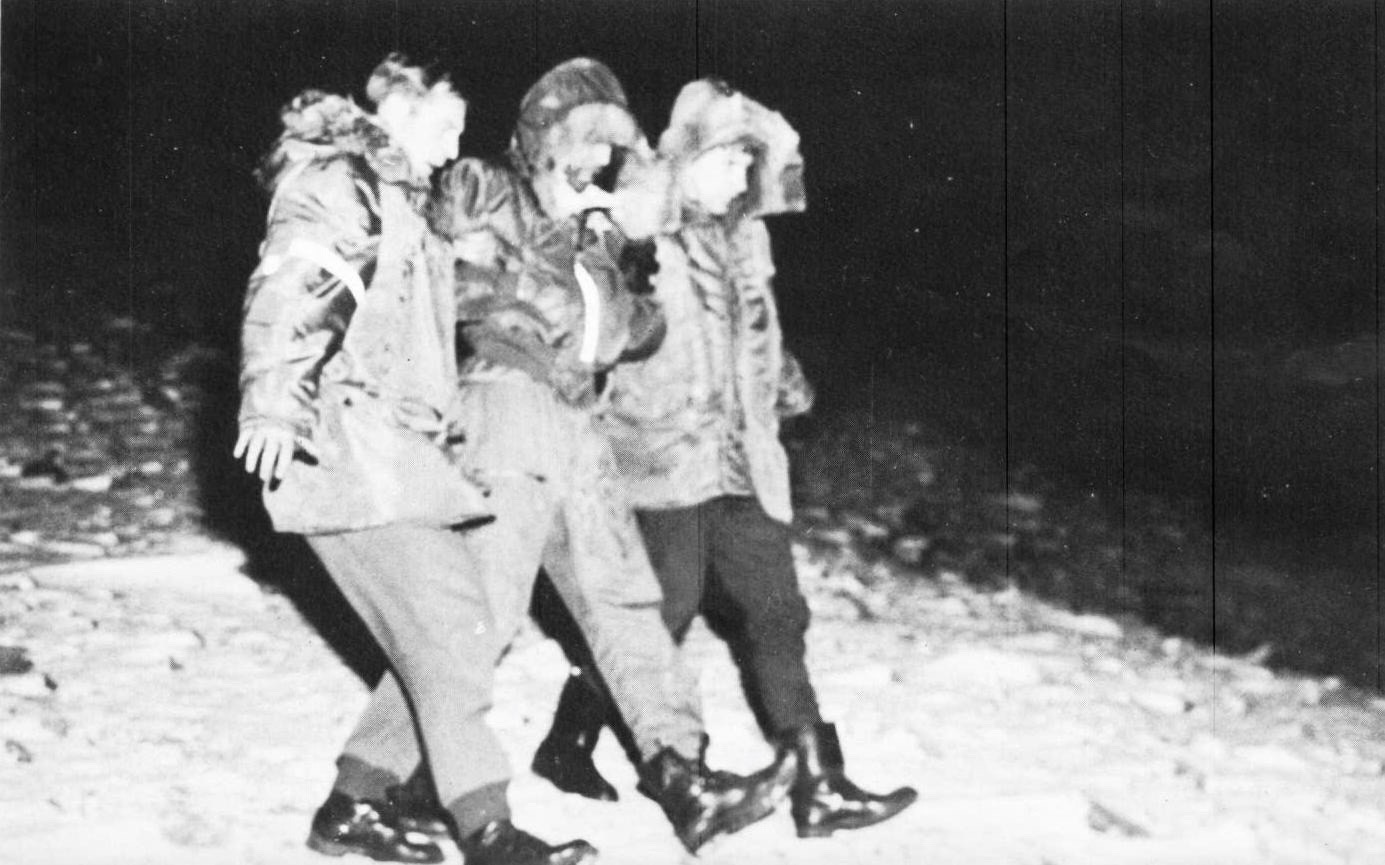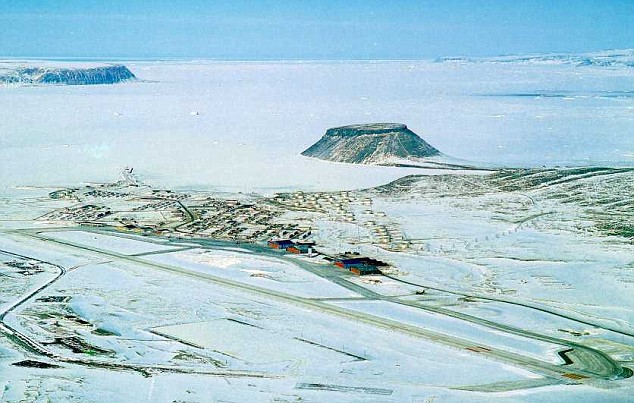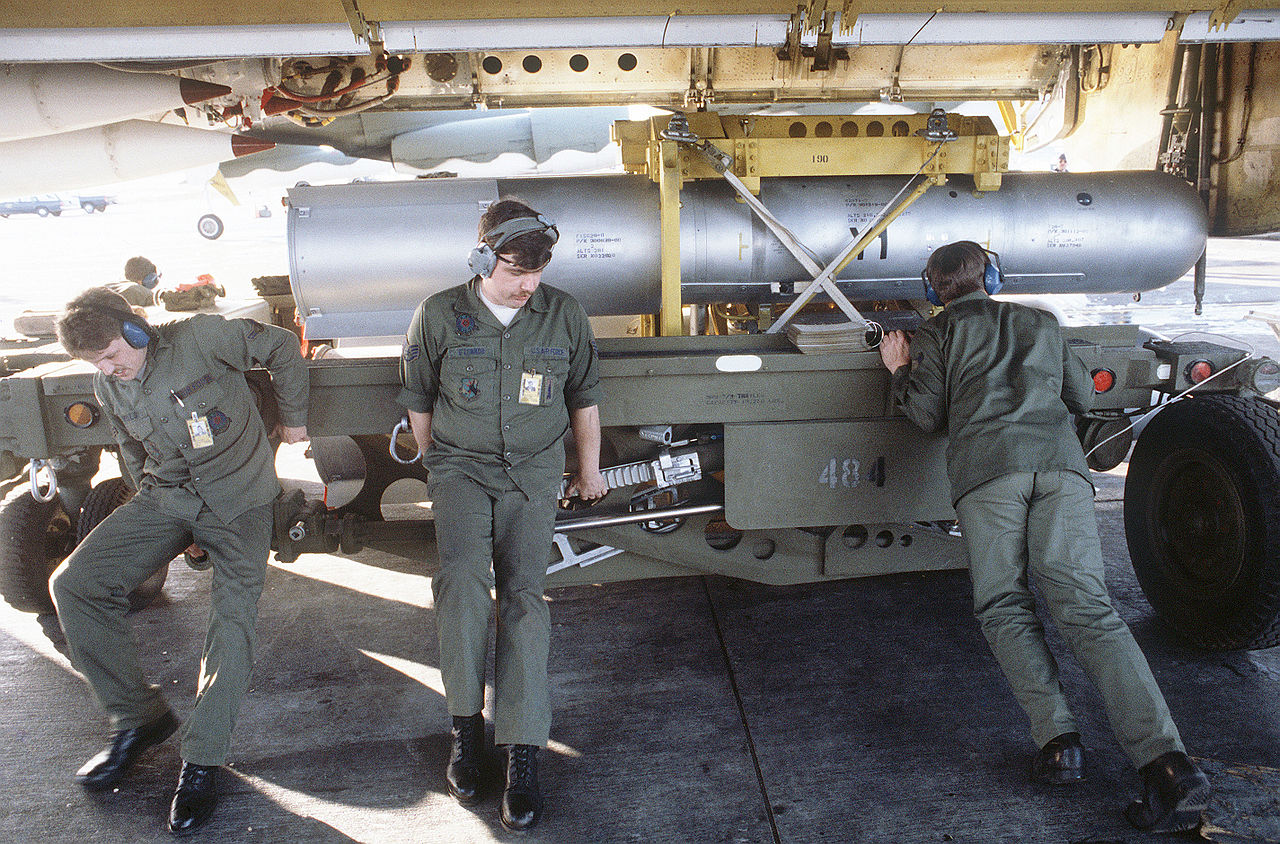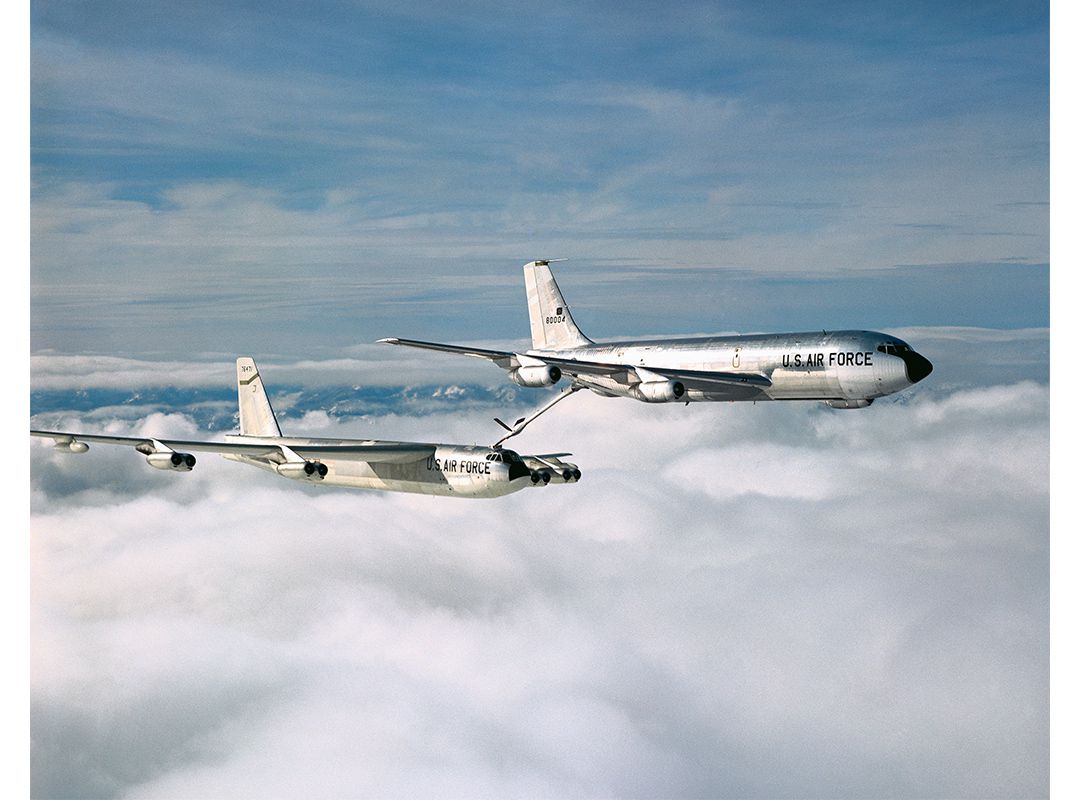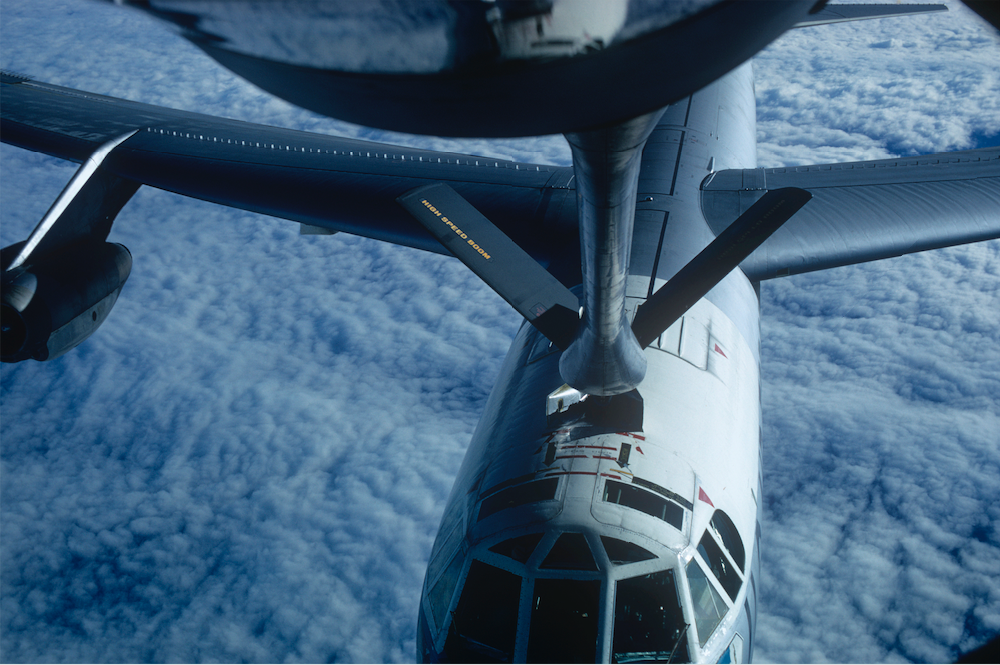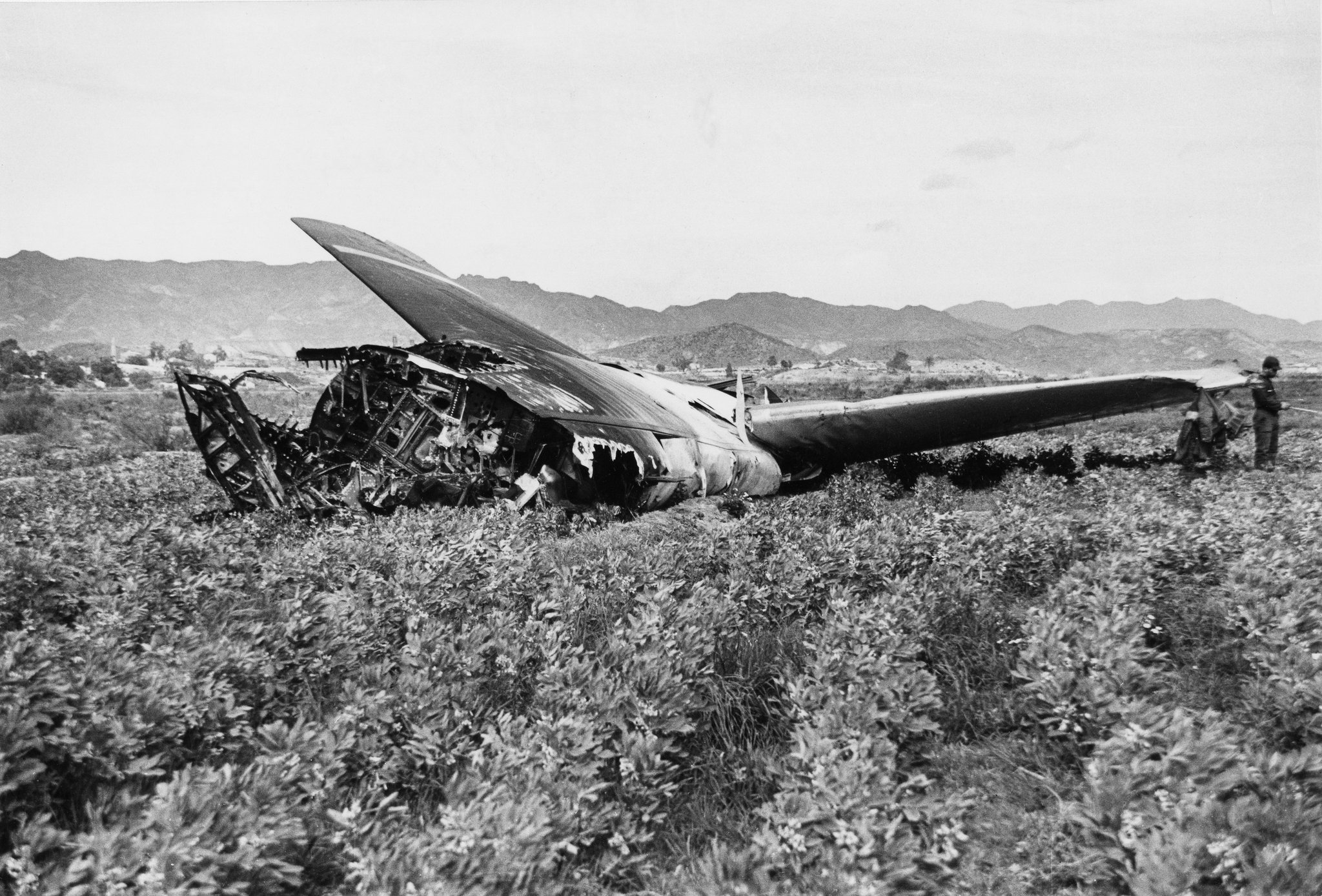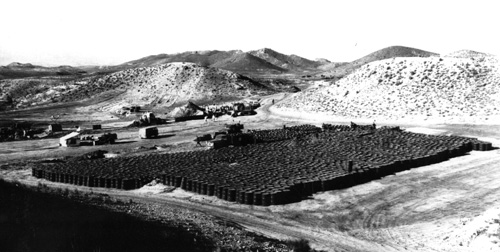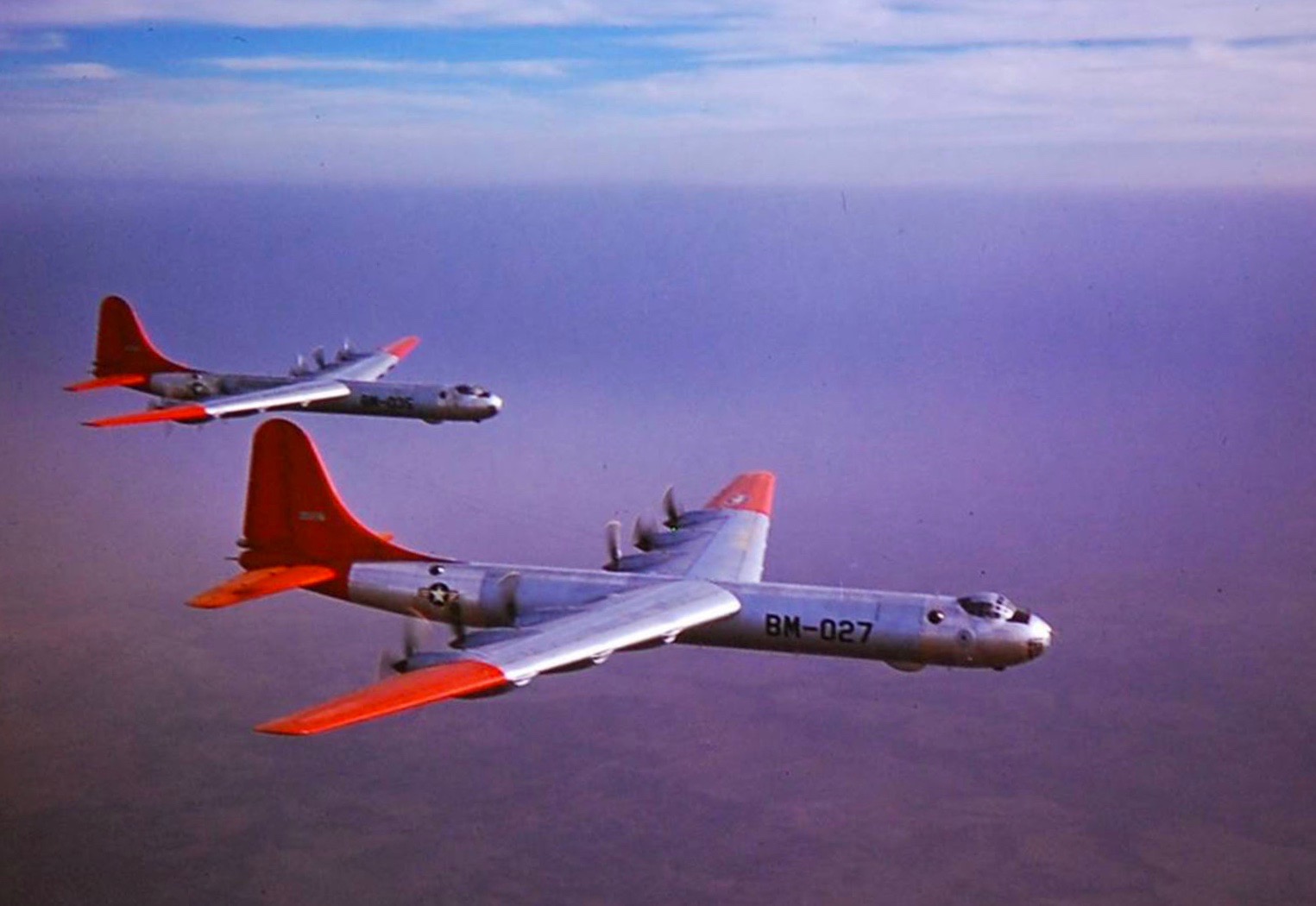
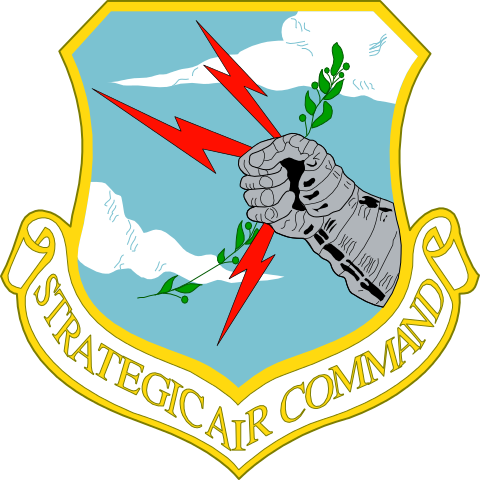 13 February 1950: Two Consolidated-Vultee B-36B Peacemaker long-range strategic bombers of the 436th Bombardment Squadron (Heavy), 7th Bombardment Wing (Heavy), Strategic Air Command, departed Eielson Air Force Base (EIL), Fairbanks, Alaska, at 4:27 p.m., Alaska Standard Time (01:27 UTC), on a planned 24-hour nuclear strike training mission.
13 February 1950: Two Consolidated-Vultee B-36B Peacemaker long-range strategic bombers of the 436th Bombardment Squadron (Heavy), 7th Bombardment Wing (Heavy), Strategic Air Command, departed Eielson Air Force Base (EIL), Fairbanks, Alaska, at 4:27 p.m., Alaska Standard Time (01:27 UTC), on a planned 24-hour nuclear strike training mission.
B-36B-15-CF 44-92075 was under the command of Captain Harold Leslie Barry, United States Air Force.¹ There were a total of seventeen men on board.
Also on board was a Mark 4 nuclear bomb.
The B-36s were flown to Alaska from Carswell Air Force Base, Fort Worth, Texas, by another crew. The surface air temperature at Eielson was -40 °F. (-40 °C.), so cold that if the bomber’s engines were shut down, they could not be restarted. Crews were exchanged and the airplane was serviced prior to takeoff for the training mission. In addition to the flight crew of fifteen, a Bomb Commander and a Weaponeer were aboard.
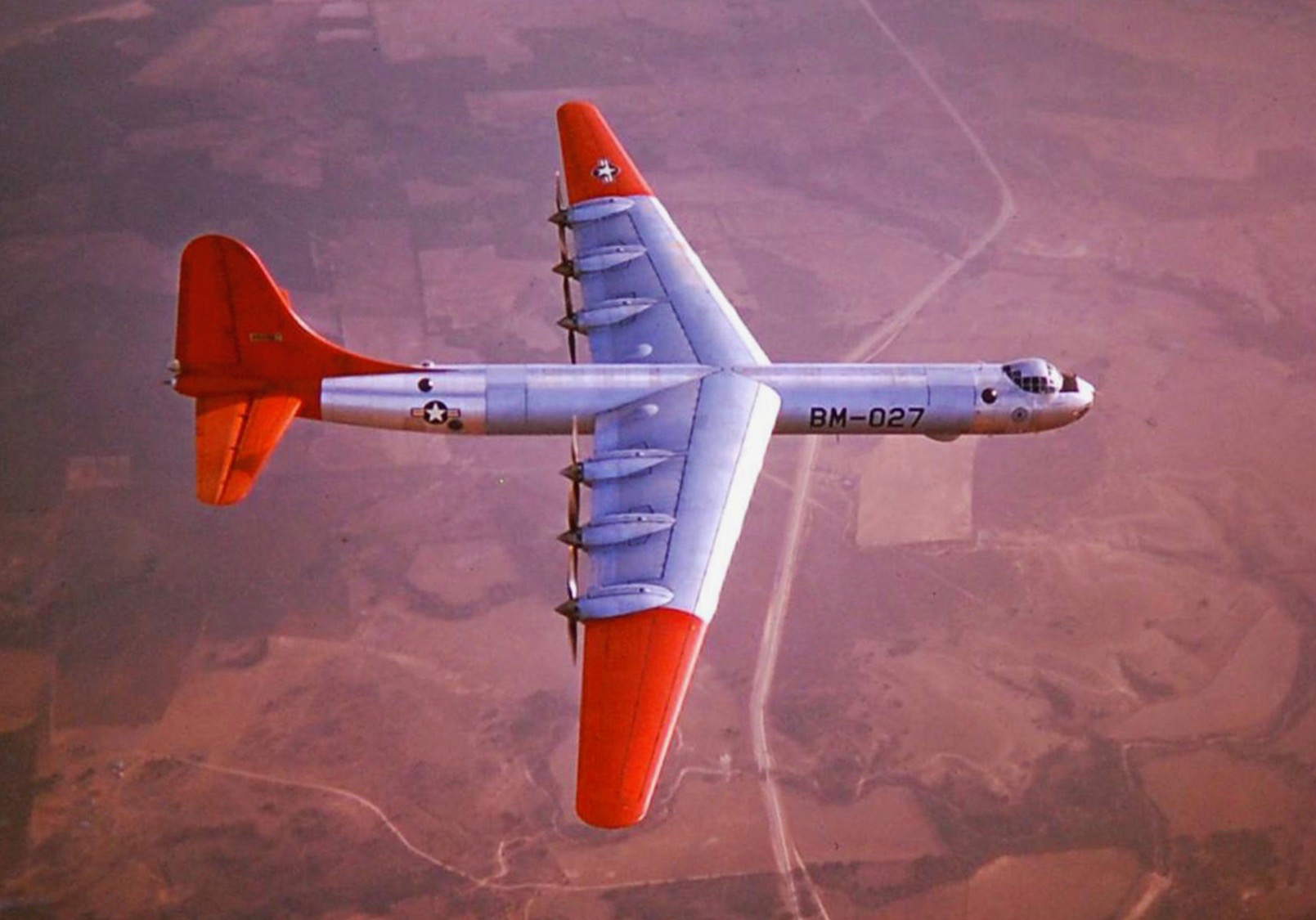
After departure, 44-92075 began the long climb toward 40,000 feet (12,192 meters). The flight proceeded along the Pacific Coast of North America toward the practice target city of San Francisco, California. The weather was poor and the bomber began to accumulate ice on the airframe and propellers.
About seven hours into the mission, three of the six radial engines began to lose power due to intake icing. Then the #1 engine, outboard on the left wing, caught fire and was shut down. A few minutes later, the #2 engine, the center position on the left wing, also caught fire and was shut down. The #3 engine lost power and its propeller was feathered to reduce drag. The bomber was now flying on only three engines, all on the right wing, and was losing altitude. When the #5 engine, center on the right wing, caught fire, the bomber had to be abandoned. It was decided to jettison the atomic bomb into the Pacific Ocean.
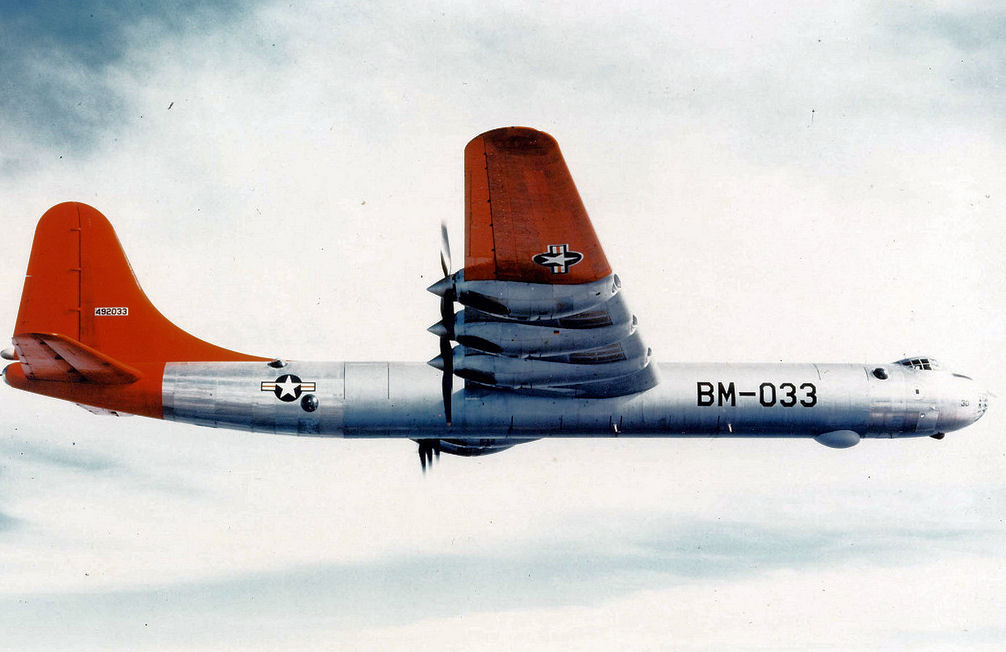
The Mark 4 did not have the plutonium “pit” installed, so a nuclear detonation was not possible. The conventional explosives would go off at a pre-set altitude and destroy the bomb and its components. This was a security measure to prevent a complete bomb from being recovered.
The bomb was released at 9,000 feet (2,743 meters), north-northwest of Princess Royal Island, off the northwest coast of British Columbia, Canada. It was fused to detonate 1,400 feet (427 meters) above the surface, and crewmen reported seeing a large explosion.
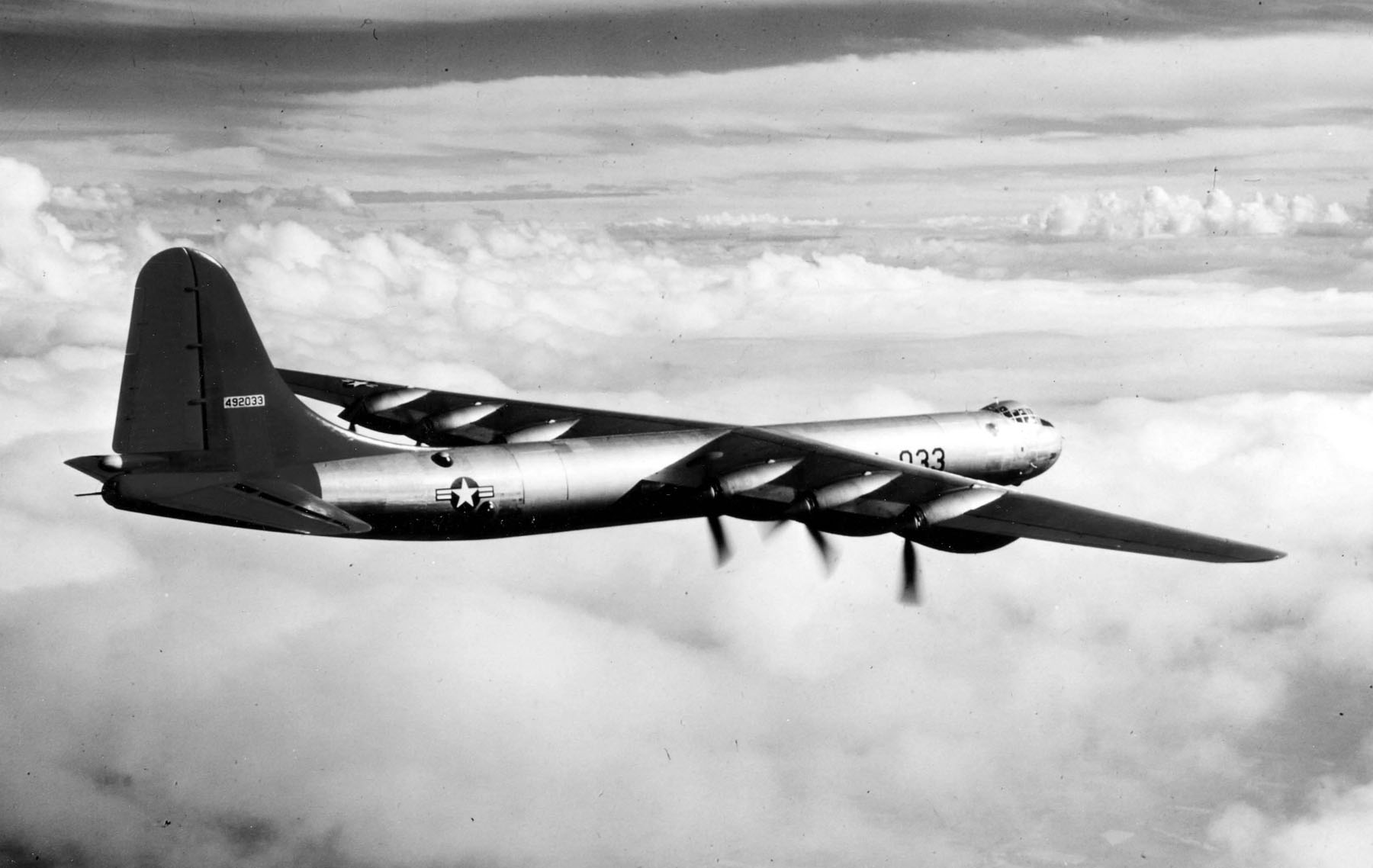
Flying over Princess Royal Island, Captain Barry ordered the crew to abandon the aircraft. He placed the B-36 on autopilot. Barry was the last man to leave 44-92075. Descending in his parachute, he saw the bomber circle the island once before being lost from sight.
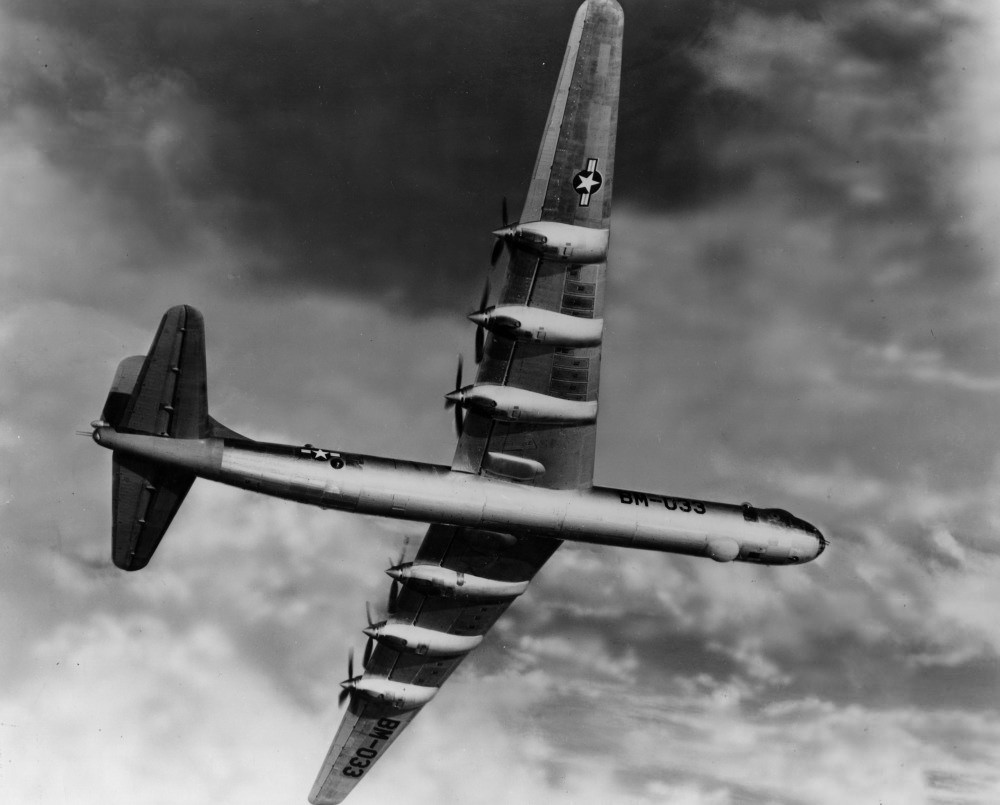
Twelve of the crew survived. Five were missing and it is presumed that they landed in the water. Under the conditions, they could have survived only a short time. The survivors had all been rescued by 16 February.
It was assumed that 44-92075 had gone down in the Pacific Ocean.
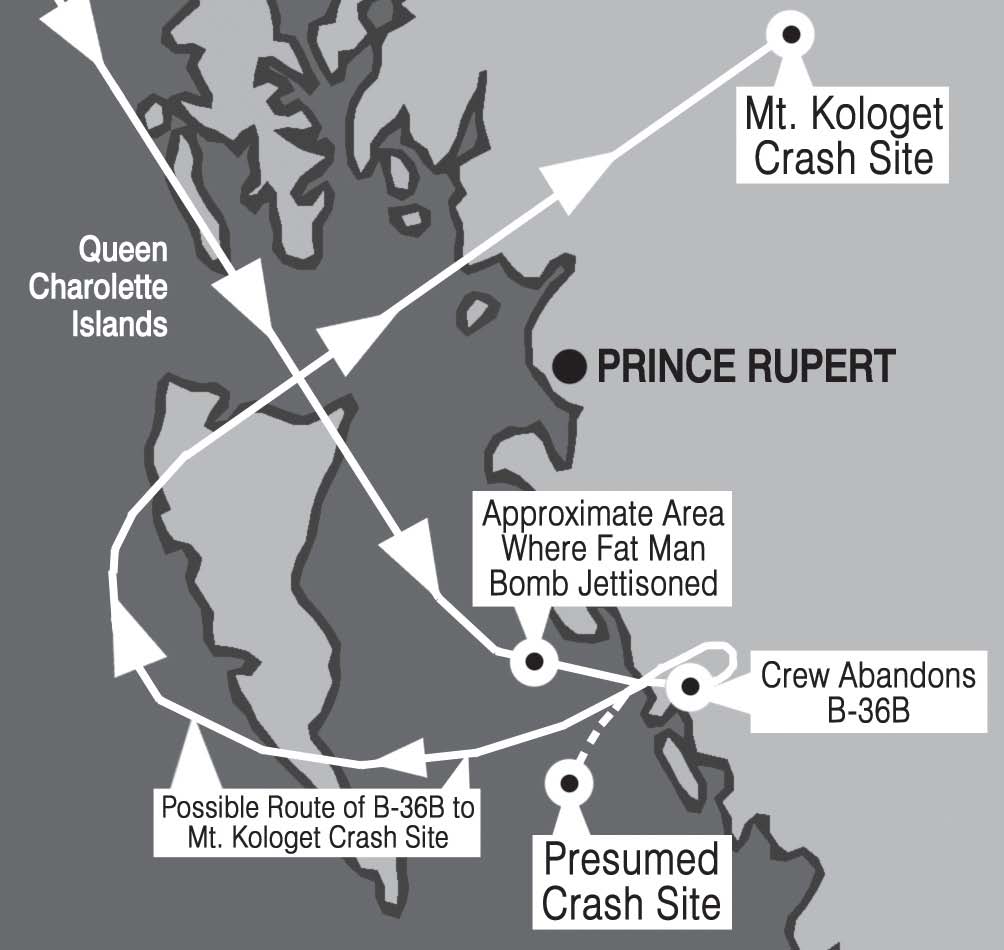
On 20 August 1953, a Royal Canadian Air Force airplane discovered the wreck of the missing B-36 on a mountain on the east side of Kispiox Valley, near the confluence of the Kispiox and Skeena Rivers in northern British Columbia.
The U.S. Air Force made several attempts to reach the crash site, but it wasn’t until August 1954 that they succeeded. After recovering sensitive equipment from the wreckage, the bomber was destroyed by explosives.
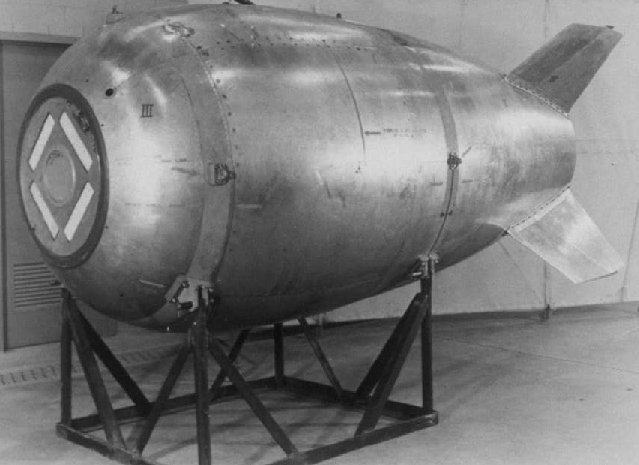
 The Mark 4 bomb was designed by the Los Alamos National Laboratory (LANL). It was a development of the World War II implosion-type Mark 3 “Fat Man.” The bomb was 10 feet, 8 inches (3.351 meters) long with a maximum diameter of 5 feet, 0 inches (1.524 meters). Its weight is estimated at 10,800–10,900 pounds (4,899–4,944 kilograms).
The Mark 4 bomb was designed by the Los Alamos National Laboratory (LANL). It was a development of the World War II implosion-type Mark 3 “Fat Man.” The bomb was 10 feet, 8 inches (3.351 meters) long with a maximum diameter of 5 feet, 0 inches (1.524 meters). Its weight is estimated at 10,800–10,900 pounds (4,899–4,944 kilograms).
The core of the bomb was a spherical composite of plutonium and highly-enriched uranium. This was surrounded by approximately 5,500 pounds (2,495 kilograms) of high explosive “lenses”—very complex-shaped charges designed to focus the explosive force inward in a very precise manner. When detonated, the high explosive “imploded” the core, crushing it into a smaller, much more dense mass. This achieved a “critical mass” and a fission chain reaction resulted.
The Mark 4 was tested during Operation Ranger at the Nevada Test Site, Frenchman Flat, Nevada, between 27 January and 6 February 1951. Five bombs were dropped from a Boeing B-50 Superfortress of the 4925th Special Weapons Group from Kirtland Air Force Base in New Mexico. The first four bombs were dropped from a height of 19,700 feet (6,005 meters) above ground level (AGL) and detonated at 1,060–1,100 feet (323–335 meters) AGL. Shot Fox was dropped from 29,700 feet (9,053 meters) AGL and detonated at 1,435 feet (437 meters) AGL. (Ground level at Frenchman Flat is 3,140 feet (957 meters) above Sea Level).

The Mark 4 was produced with explosive yields ranging from 1 to 31 kilotons. 550 were built.
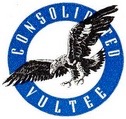 Consolidated-Vultee B-36B-15-CF Peacemaker 44-92075 was completed at Air Force Plant 4, Fort Worth, Texas, on 31 July 1949. It had been flown a total of 185 hours, 25 minutes.
Consolidated-Vultee B-36B-15-CF Peacemaker 44-92075 was completed at Air Force Plant 4, Fort Worth, Texas, on 31 July 1949. It had been flown a total of 185 hours, 25 minutes.
The B-36B is 162 feet, 1 inch (49.403 meters) long with a wingspan of 230 feet (70.104 meters) and overall height of 46 feet, 8 inches (14.224 meters). The wings’ leading edges were swept aft 15° 5′ 39″. Their angle of incidence was 3°, with -2° twist and 2° dihedral. The empty weight is 137,165 pounds (62,217 kilograms) and the maximum takeoff weight was 326,000 pounds (147,871 kilograms).
With a wing area of 4,772 square feet (443 square meters) and 21,000 horsepower, the B-36 could fly far higher than any jet fighter of the early 1950s.
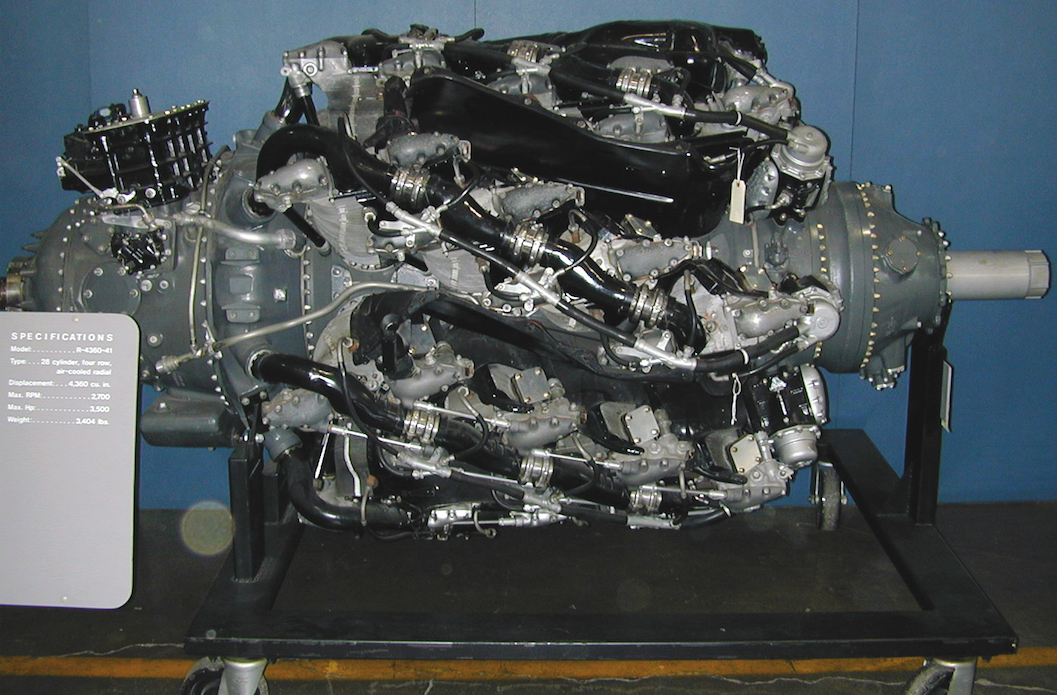
 The B-36B was powered by six air-cooled, supercharged and turbocharged 4,362.49 cubic-inch-displacement (71.488 liter) Pratt & Whitney Wasp Major B4 (R-4360-41) four-row, 28-cylinder radial engines placed inside the wings in a pusher configuration. These had a compression ratio of 6.7:1 and required 115/145 aviation gasoline. Each engine was equipped with two General Electric BH-1 turbochargers. The R-4360-41 had a Normal Power rating of 2,650 horsepower at 2,550 r.p.m. Its Takeoff/Military Power rating was 3,500 horsepower at 2,700 r.p.m., with water/alcohol injection. The engines turned three-bladed Curtiss Electric constant-speed, reversible propellers with a diameter of 19 feet, 0 inches (5.791 meters) through a 0.375:1 gear reduction. The R-4360-41 is 9 feet, 1.75 inches (2.788 meters) long, 4 feet, 6.00 inches (1.372 meters) in diameter, and weighs 3,567 pounds (1,618 kilograms).
The B-36B was powered by six air-cooled, supercharged and turbocharged 4,362.49 cubic-inch-displacement (71.488 liter) Pratt & Whitney Wasp Major B4 (R-4360-41) four-row, 28-cylinder radial engines placed inside the wings in a pusher configuration. These had a compression ratio of 6.7:1 and required 115/145 aviation gasoline. Each engine was equipped with two General Electric BH-1 turbochargers. The R-4360-41 had a Normal Power rating of 2,650 horsepower at 2,550 r.p.m. Its Takeoff/Military Power rating was 3,500 horsepower at 2,700 r.p.m., with water/alcohol injection. The engines turned three-bladed Curtiss Electric constant-speed, reversible propellers with a diameter of 19 feet, 0 inches (5.791 meters) through a 0.375:1 gear reduction. The R-4360-41 is 9 feet, 1.75 inches (2.788 meters) long, 4 feet, 6.00 inches (1.372 meters) in diameter, and weighs 3,567 pounds (1,618 kilograms).
The B-36B Peacemaker had a cruise speed of 193 knots (222 miles per hour/357 kilometers per hour) and a maximum speed of 338 knots (389 miles per hour/626 kilometers per hour) at 35,500 feet (10,820 meters). The service ceiling was 43,700 feet (13,320 meters) and its combat radius was 3,710 nautical miles (4,269 statute miles/6,871 kilometers). The maximum ferry range was 8,478 nautical miles (9,756 statute miles/15,709 kilometers).
The B-36 was defended by sixteen M24A-1 20 mm automatic cannons. Six retractable gun turrets each each had a pair of 20 mm cannon, with 600 rounds of ammunition per gun (400 r.p.g.for the nose guns). These turrets were remotely operated by gunners using optical sights. Two optically-sighted 20 mm guns were in the nose, and two more were in a tail turret, also remotely operated and aimed by radar.
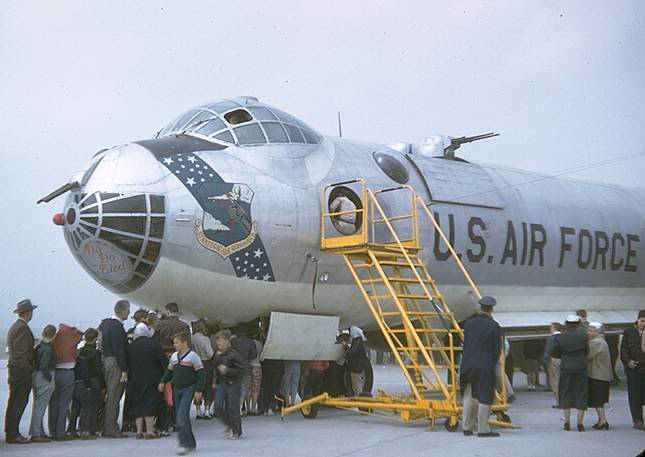
The B-36 was designed during World War II and nuclear weapons were unknown to the Consolidate-Vultee Aircraft Corporation engineers. The bomber was built to carry up to 86,000 pounds (39,009 kilograms) of conventional bombs in the four-section bomb bay. It could carry two 43,600 pound (19,777 kilogram) T-12 Cloudmakers, a conventional explosive earth-penetrating bomb. When armed with nuclear weapons, the B-36 could carry several Mk.15 thermonuclear bombs. By combining the bomb bays, one Mk.17 25-megaton thermonuclear bomb could be carried.
Between 1946 and 1954, 384 B-36 Peacemakers were built by Convair. 73 of these were B-36Bs, the last of which were delivered to the Air Force in September 1950. By 1952, 64 B-36Bs had been upgraded to B-36Ds.
The B-36 Peacemaker was never used in combat. Only four still exist.
¹ Captain Barry was killed along with other 11 crewmen, 27 April 1951, when the B-36D-25-CF on which he was acting as co-pilot, 49-2658, crashed following a mid-air collision with a North American F-51-25-NT Mustang, 44-84973, 50 miles (80 kilometers) northeast of Oklahoma, City, Oklahoma, U.S.A. The Mustang’s pilot was also killed.
© 2020, Bryan R. Swopes
